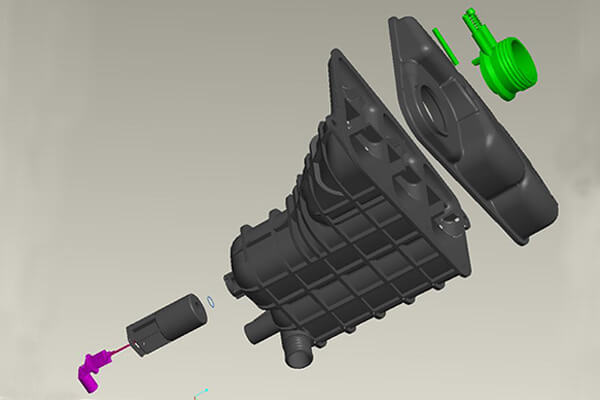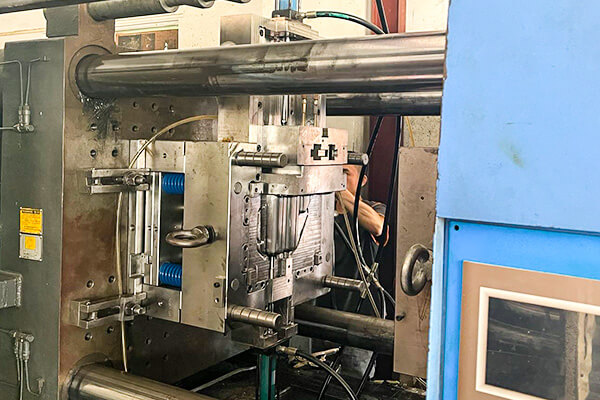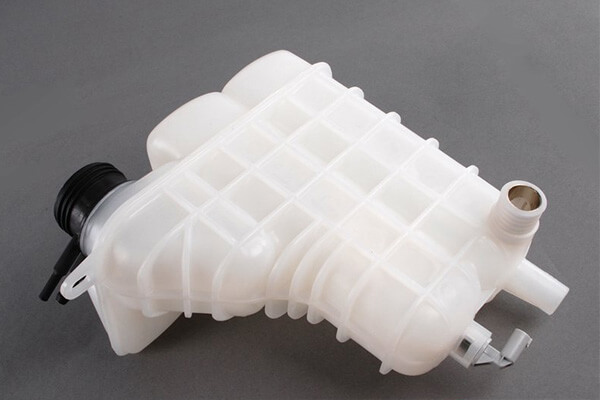How Does Injection Molding Work?



What is Injection Molding?
Injection molding is a popular manufacturing process used to produce parts in large volumes. It’s most commonly used in mass-production processes where the same part is being created thousands or even millions of times in succession.
How Does Injection Molding Work
Injection molding’s fundamental manufacturing procedure, plastic is melted in a machine for injection molding and then injected under strong pressure into a mold. There, the substance is cooled, consolidated, and then released by cracking open the mold’s two parts. A plastic object with a specified, fixed form is produced using this technology.
The components involved in the plastic injection moulding process must be carefully developed in order to simplify production. An industrial engineer or a designer creates the initial designs for the objects produced by plastic injection molding machines. The mold is then made by a moldmaker, typically out of steel or aluminum. This toolmaker considers all pertinent factors, including: the components utilized to create the final product, as well as its features, the characteristics of the plastic injection molding machine and the mold’s substance.
Injection Molding Process
Here’s a general steps of how does injection molding work:
- 1. Material Preparation
- 2. Melting
- 3. Injection
- 4. Cooling
- 5. Ejection
- 6. Post-processing
The process begins with the preparation of the material. The raw material, usually in the form of pellets, is fed into the injection molding machine, and advanced towards the mold by the injection unit.
During this process, the material is melted by heat and pressure. The plastic is melted until it becomes a liquid. This is done inside the injection molding machine. A screw or a ram is typically used to force the material through the machine.
Once the plastic is melted, it’s then injected into the mold. The speed, pressure, and amount of the material injected can be controlled during this process.
After the plastic is injected into the mold, the cooling process begins. This allows the material to solidify and take the shape of the mold. The cooling is typically done by circulating water or another coolant around the mold.
After the part has cooled and solidified, it’s then ejected from the mold. The ejection can be done with pins, or a plate that pushes the part out of the mold. The mold then closes for the next shot (injection), and the process starts again.
Sometimes, the part will require some post-processing like deburring (to remove excess plastic), painting, or assembly of multiple parts.
Injection molding allows for a high level of repeatability and good control over the manufacturing process. It’s a great way to produce high volumes of identical parts. However, the initial costs can be high due to the design, testing, and tooling of molds.
The design of the part, the material used, and the particular process parameters (temperature, pressure, cycle time, etc.) can all impact the final characteristics of the molded part, including its strength, surface finish, dimensional accuracy, and more.
Advantages and Disadvantages of Injection Molding
Injection molding is a widely used manufacturing process that offers several advantages, but it also has its limitations. Understanding the advantages and disadvantages of injection molding can help you determine if it is the right manufacturing method for your product. Let’s explore them in detail.
Advantages of Injection Molding
- 1. High Efficiency and Production Rates: Injection molding allows for high-volume production with rapid cycle times. It enables the production of large quantities of parts in a relatively short time, making it suitable for mass production.
- 2. Design Flexibility: Injection molding offers a high degree of design freedom. Complex part geometries, intricate details, and undercuts can be easily achieved. It allows for the integration of multiple features into a single part, reducing the need for assembly.
- 3. Precision and Consistency: Injection molding produces highly precise and consistent parts. The use of computer-controlled machines ensures accuracy and repeatability, resulting in minimal variations between parts.
- 4. Material Variety: Injection molding supports a wide range of materials, including various thermoplastics, thermosetting plastics, elastomers, and even metals. This versatility allows for the selection of materials that meet specific product requirements, such as mechanical strength, chemical resistance, or flexibility.
- 5. Cost-effective for High-volume Production: Injection molding can be cost-effective for large production runs. Once the initial tooling costs are incurred, the per-unit cost decreases significantly, making it an efficient choice for high-volume manufacturing.
- 6. Durability and Reliability: Injection molding utilizes incorporating fillers into the injection molds, the density of the plastic material can be decreased, resulting in stronger parts that can withstand greater stress and wear over time.
- 7. Automation: Injection molding is known for its consistent and reliable results, in large part due to the extensive automation of the manufacturing process. By relying on automated machinery, the chances of human error are minimized, and parts can be produced at a consistent rate with a high fulfillment rate.
Disadvantages of Injection Molding
- 1. High Initial Tooling Costs:
- 2. Limited Design Changes:
- 3. Long Lead Times:
- 4. Environmental Impact:
- 5. Size and Shape Limitations:
One of the primary drawbacks of injection molding is the high upfront investment required for tooling. Designing and manufacturing molds can be expensive, especially for complex parts. This cost can be a barrier for small-scale or custom production runs.
Once the mold is created, making design changes can be costly and time-consuming. Modifications to the mold may require significant adjustments or even the creation of a new mold altogether. This limitation can restrict design flexibility, particularly for products undergoing frequent design iterations.
Developing molds and setting up the injection molding process can take time. From designing and manufacturing molds to testing and refining the process, the lead time can be longer compared to other manufacturing methods. This can be a disadvantage when quick turnaround times are required.
Injection molding has environmental considerations. The process generates waste in the form of scrap material, and the disposal of plastic waste can be a challenge. However, efforts are being made to promote recycling and reduce the environmental footprint of injection molding.
While injection molding offers design flexibility, there are limitations in terms of the size and shape of parts that can be produced. Extremely large or bulky parts may not be suitable for injection molding, requiring alternative manufacturing methods.
It is important to carefully consider these advantages and disadvantages in the context of your specific product requirements, production volume, budget, and timeline. Consulting with experienced manufacturers and experts can help you make an informed decision regarding the suitability of injection molding for your project.
Materials Used in Injection Molding
The most common material used in injection molding is thermoplastic, which can be melted and solidified repeatedly without changing its properties. However, other materials such as thermosetting plastics, elastomers, metals, and ceramics can also be used.
Injection molding can use a wide variety of materials including:
- 1. Thermoplastics:
- 2. Thermosets:
- 3. Elastomers:
- 4. Composites:
These are the most commonly used materials in injection molding. They are polymers that can be melted and re-melted repeatedly without any significant degradation. Examples of thermoplastics include polypropylene, polyethylene, polystyrene, and PVC.
These materials are polymers that are cured or cross-linked during the molding process, giving them enhanced strength and durability. Examples of thermosets include epoxy resins, phenolic resins, and urea-formaldehyde.
These materials are rubber-like polymers that can be stretched and returned to their original shape. They are commonly used in applications that require flexibility and shock absorption. Examples of elastomers include silicone, neoprene, and natural rubber.
These materials are made by combining two or more different materials to create a new material with enhanced properties. For example, glass fiber-reinforced thermoplastics are commonly used in automotive applications due to their high strength and stiffness.
Some of the most commonly used materials in injection molding include:
This is a versatile thermoplastic that is lightweight, durable, and resistant to moisture and chemicals. It is commonly used in packaging, automotive parts, and consumer goods.
This is a thermoplastic that is tough, rigid, and impact-resistant. It is often used in automotive parts, electronic housings, and toys.
This is a lightweight thermoplastic that is flexible, strong, and resistant to moisture and chemicals. It is commonly used in packaging, piping, and consumer goods.
This is a versatile thermoplastic that is lightweight, rigid, and easy to process. It is often used in packaging, disposable utensils, and toys.
This is a thermoplastic that is strong, lightweight, and resistant to moisture and chemicals. It is commonly used in beverage bottles, food containers, and cosmetic packaging.
This is a thermoplastic that is durable, lightweight, and resistant to weathering and chemicals. It is commonly used in pipes, electrical cable insulation, and construction materials.
Different types of plastics have different properties, such as flexibility, strength, and durability. The choice of material depends on the product’s requirements, such as its function, appearance, specific properties required for the finished product, the intended application, and the cost of the material. Other factors to consider include the melting temperature, flowability, and shrinkage of the material during the molding process. The material must also be compatible with the molding machine and the mold design.
Applications of Injection Molding
Injection molding is used in several industries, such as automotive, aerospace, medical devices, and consumer products. It’s used to manufacture a wide range of products, such as car parts, toys, medical devices, and packaging.
Here are some common applications of injection molding:
- 1. Automotive parts: Injection molding is used to manufacture a variety of automotive parts, including dashboards, bumpers, and interior trims.
- 2. Medical devices: Injection molding is used to produce medical devices such as syringes, inhalers, and surgical instruments.
- 3. Consumer goods: Injection molding is used to produce a wide range of consumer goods, including toys, kitchenware, and electronic components.
- 4. Packaging: Injection molding is used to manufacture a variety of packaging components, such as bottle caps, closures, and containers.
- 5. Aerospace: Injection molding is used to manufacture lightweight, high-strength components for the aerospace industry.
- 6. Construction: Injection molding is used to produce components for the construction industry, such as electrical boxes, plumbing fittings, and insulation.
Overall, injection molding is a versatile and efficient method for producing high-quality, precise components for a wide range of applications.
Differences Between Injection Molding and CNC Machining Fast Prototyping
Injection molding and CNC machining fast prototyping are two different techniques for shaping materials. Continue to know more about: How does injection molding work and how does CNC machining fast prototyping work?
Injection molding involves heating materials until they become liquid, then injecting them into a pre-designed mold where they cool and solidify to take on the mold’s shape.
CNC machining fast prototyping, on the other hand, starts with a solid block of material that is gradually shaped using advanced machinery. This subtractive process involves removing excess material until the desired object is achieved.
While injection molding is better suited for mass production due to its high repeatability, CNC machining fast prototyping is more effective at creating intricate, precise parts in smaller quantities.
There are the specific differences between injection molding and CNC machining fast prototyping for fast prototyping:
- 1. Material: Injection molding is typically used with thermoplastics, thermosets, and elastomers, whereas CNC machining fast prototyping can be used with a wider range of materials, including metals, plastics, and composites.
- 2. Complexity: Injection molding can produce complex geometries and intricate details, whereas CNC machining fast prototyping is better suited for simpler geometries and features.
- 3. Lead time: Injection molding requires the design and manufacture of a mold, which can take several weeks or even months. CNC machining fast prototyping, on the other hand, can produce parts much more quickly, often within a few days.
- 4. Cost: Injection molding is typically more expensive than CNC machining fast prototyping for small production runs due to the cost of designing and manufacturing the mold. However, for larger production runs, injection molding can be more cost-effective.
Both injection molding and CNC machining fast prototyping have their advantages and disadvantages when it comes to fast prototyping. The choice of method depends on several factors, including the desired material, complexity of the part, lead time, and budget.
How to Speed Up Injection Molding
The injection molding process can be divided into three stages: injection time, cooling time, and resetting or changeover time. By minimizing any of these stages, production costs can be decreased. Regular mold changes not only reduce inventory but also enable a faster response to changing market demands.
FAQs About How Injection Molding Works
- 1.What factors affect the process of injection molding?
Several factors can affect the quality of injection molded parts, including the temperature and pressure of the molding machine, the design of the mold, and the properties of the plastic material being used. Proper control of these factors is essential to ensuring consistent, high-quality injecting molding parts.
- 2. What is the role of the mold in injection molding?
The mold is a crucial component in the injection molding process. It is designed to define the shape of the final product and is made up of two halves. The molten plastic is injected into the mold cavity, where it cools and solidifies to take on the shape of the mold.
- 3. How is the quality of injection molded parts controlled?
Quality control in injection molding involves monitoring and controlling several variables, such as temperature, pressure, and cooling time, to ensure that the finished parts meet the desired specifications. Additionally, quality control measures may include visual inspection, dimensional measurement, and material testing.
Sungplastic: Injection Molding Maker – All You Need to Know.
Welcome to request a quote, and consult with your vital projects!
About Sungplastic
Sungplastic is a plastic product manufacturer with rich experience in injection molding. According to the different product development requirements, we flexibly adjust the manufacturing process to achieve high quality, high efficiency and more economical.
We offer a variety of manufacturing services: Rapid Prototyping, Tool Making, Injection Molding, Product Design and Development, CNC Machining and Metal Stamping. You can choose from a variety of plastics, silicone rubber, or metal for your product. Regardless of mass production or small batch customization, Sungplastic has always been committed to providing assured, efficient and more economical one-stop processing services for your projects.
Contact us for a free quote and project review.
Get a free quote and design analysis today.
We’ll reply you within 6 working hours.
We respect your privacy.
